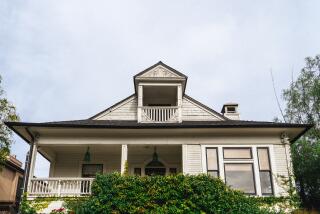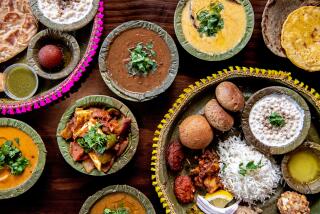Living like royalty in Rajasthan
- Share via
Rajasthan, India
This land of kings is dotted with the centuries-old opulent palaces, hilltop forts and hunting lodges of maharajahs. And, luckily for travelers, many of these palatial digs are surprisingly affordable luxury hotels.
On our first trip to India last November, my husband, Larry, and I wanted to live like royalty in Rajasthan’s heritage hotels — once-private royal residences turned hostelries, some with the maharajahs still in residence — while we traveled through the northwestern state.
India can challenge the most experienced Western traveler, so instead of booking our own arrangements we chose a custom tour. Terrorism didn’t worry us, but delayed trains, broken buses, scam artists and Delhi belly did.
Larry found a 16-day tour offered by Indian Moments, a small Jaipur-based company, that included A-list hotels and a private car and driver. The trip was so tempting that we invited our friend Peter Burleigh, a retired Foreign Service officer with decades of South Asia experience. The final tab covered hotels with breakfast, transportation, sightseeing and airfare between Udaipur and Delhi, the capital. Meals, tips and entrance fees were excluded. The cost came to $1,737 each for Larry and me, and $2,674 for Peter, who had to pay a single surcharge.
We would have saved money planning the trip ourselves. But as we learned soon after our arrival at Delhi airport, tour agent’s assistance is priceless.
“I am sorry, but the Imperial Hotel is overbooked and has canceled your reservation,” the tour agent told us shortly after our 1 a.m. arrival. He switched us to a suite at the Grand Inter-Continental, which was fine, although it lacked the Imperial’s Raj-infused glamour.
Delhi is a scruffy, noisy, dusty city of 14 million people and horrendous traffic. We spent a day of whirlwind sightseeing, evading hawkers and listening to the stale patter of our tiresome guide. It was an inauspicious beginning, but we left the din behind the next day when we set out for Agra in an air-conditioned Ambassador car.
It was the first of many long, harrowing drives. But our driver, Rishi Raj, was brave and chivalrous as he expertly maneuvered around huge trucks, bullock carts, wandering cows, overloaded tractors, wild dogs, camels and scooters.
I was distracted from thoughts of my imminent demise by the vivid costumes of Rajasthani women. Even the poorest ones looked like bouquets. Their full skirts, midriff tops and veils of magenta, parrot green, acid yellow, bright orange and cerise vibrated in the sun.
The brilliance of Rajasthani dress contrasted sharply with the parched landscape, bone dry after years of weak monsoons, deforestation and over-pumping of groundwater. The well-irrigated gardens, green and full of blooms, surrounding Jaypee Palace, our hotel in Agra, were a welcome sight.
Despite its name, this wasn’t a heritage hotel but a new 350-room conference center with a swimming pool, three restaurants and an astrologer on call. We settled into our spacious room, then met our guide for a Taj Mahal tour.
Shikha Oberoi Sharma knew her Mogul history and gave us an insightful half-day tour of the jewel-inlaid Taj Mahal. I was flabbergasted by the tomb’s scale, its delicate marble carving and fine inlay of coral, carnelian and ebony. The mausoleum was built by Emperor Shah Jahan in tribute to his second wife, Mumtaz, who died in childbirth in 1631.
Sharma was the best guide we had in India, all of whom were hired by Indian Moments. On an afternoon tour of Fatehpur Sikri, a little-visited but well-preserved 16th century palace complex west of Agra, she described daily court life under Akbar, who ruled most of India from 1556 to 1605 before British traders arrived in the early 17th century.
Sharma described the Mogul emperor in his pleasure garden, reclining on richly patterned carpets and silken cushions while listening to court musicians and watching beautiful maidens dance across a giant Parcheesi board. Palace walls were painted with gold and crushed semiprecious stones, traces of which were still evident.
Our next overnight stop was Bharatpur, where we would tour Keoladeo National Park, a bird sanctuary with more than 350 migratory species attracted to the semiarid plain that floods during the monsoon. That night we stayed in our first palace, Laxmi Vilas, the home of descendants of Ragunath Singh, a minor maharajah. It reeked of eccentric charm. Rooms were furnished with ancient brass beds and washstands, old mahogany dressers and sepia photos of 1930s hunting parties with the maharajah and visiting dignitaries, posing among bags brimming with 4,000 birds.
These days wandering cattle and drought, not hunting, threaten wildlife. A sign at the park’s entrance warned that the number of waterfowl had dwindled. Nonetheless, Larry checked off many species in his “Birds of India” book — three kinds of eagles, iridescent blue-green kingfishers and Indian rollers, an oriole and spotted owlets.
That evening we ate in the palace’s small tiled courtyard, seated not far from the owners. After the bland meals we had been served since our arrival, dinner was a revelation. The butter chicken, yellow lentils, aloo paneer (potatoes and cheese), roti (fried bread), yogurt and spicy homemade lime pickles were the best food we had eaten so far. From then on we gushed about our love of spicy food at every meal and were rewarded with delicious specialties.
After dinner we were invited upstairs to a small room, where the maharani was performing her evening worship. She rang a small bell to call the deity and circulated a burning oil lamp. Then she made offerings of fruit, flowers and water from the Ganges to a half-dozen brightly colored paintings of the Hindu deity Krishna.
Tiger-spotting at Ranthambhore National Park, 155 miles away, was next, and we stayed nearby at Sawai Madhopur, built in 1930 as the hunting lodge for the maharajah of Jaipur, Sawai Man Singh II, a champion polo player. Stuffed leopards decorated the dining room, which opened onto a semicircular porch overlooking an expanse of lawn with a cricket pitch. A chart in the lobby listed tiger sightings — one female and three cubs at 4:55 p.m. Tuesday.
Our twin-bedded room with bath was comfy, but dinner was a disappointment: a small half-Western, half-Indian buffet of mediocre curries, spaghetti and French fries.
The next two days we spent with Pankaj Joshi, a self-taught naturalist in a bush hat, bouncing along dusty trails. Park rules confined us to a jeep, but we got good looks at spotted and golden deer, blue bulls, peacocks, monkeys, painted storks, wild boar, mongoose, marsh crocodile and a crested serpent eagle. Of the park’s 38 tigers, alas, we saw none. More fortunate guests told us they saw five at a go.
Our early November trip coincided with Diwali, the Hindu festival of lights. From crowded cities to isolated villages, households were preparing for a visit from Lakshmi, the goddess of wealth. We passed women decorating the walls and doorsteps of their mud and thatch houses with rangoli, elaborate rice powder designs.
As we arrived at Rambagh Palace in Jaipur, a man was sprinkling pink rose petals and yellow marigolds in alternating strips along the courtyard.
The sprawling palace was once the principal home of Sawai Man Singh II. The maharajah, his three wives, their children and 400 retainers occupied the 100-room palace, built in the 1800s in a 47-acre garden and expanded after 1922. His two older wives were kept in seclusion, and the youngest, Gayatri Devi, atypical for a woman of her time, was his hostess.
Devi, once considered one of the 10 most beautiful women in the world, shot tigers, rode horses, drove cars, wore slacks and summered with film stars on the Riviera. Now in her 80s, she lives quietly on the palace grounds.
Holiday shopping
THE “Pink City of Jaipur,” so named because of its rose-painted buildings, was mobbed with holiday shoppers buying sweet cakes, candles, new clothes and toys. On Diwali Eve, we shouldered our way through the crowds to sample paan (leaves stuffed with betel nut) and buy bangle bracelets.Our hectic two-day stay in Jaipur included visits to a block-printing factory in nearby Sanganer; elephant rides at the Amber Fort, a palace built atop a bluff; tours of the City Palace museum; and an 18th century outdoor observatory of giant marble instruments.
During the next three evenings, we ate in the cavernous Suvarna Mahal (Gold Palace), the silk brocade-lined banquet hall where the royal couple once entertained Lord and Lady Mountbatten, Jacqueline Kennedy and Queen Elizabeth II.
Of all the palace hotels we stayed in, our favorite was Deogarh Mahal, a honey-colored fantasy of balconies, domed turrets, parapets and terraces midway between Jaipur and Udaipur. In just one night, we got acquainted with the Chundawat family, descendants of feudal barons, who have lovingly restored the 17th century palace.
Over drinks on the terrace, the current rawat, or clan ruler, Nahar Singh II, a retired history professor, told us his father never recovered from the loss of royal privileges after India’s independence in 1947. After his mother’s death in 1966, the family closed the place.
Ten years ago, Singh, his wife and their two sons decided to convert the palace into a hotel. The sons quit their jobs, sold land and pooled resources to raise money.
“Amazingly, nothing had been pilfered,” Nahar Singh told us.
The bedrooms have mirrored ceilings, stained-glass windows, hand-painted dados of hunting scenes and alcoves piled high with silk bolsters.
I was looking forward to the Lake Palace Hotel, built on an island in the middle of Udaipur’s Lake Pichola. For years I had admired it in the PBS series “Jewel in the Crown” and the James Bond flick “Octopussy.”
Unfortunately, it did not live up to my fantasy. On departure I handed in a comment card complaining about our newly refurbished rooms: no hot water, a malfunctioning hair dryer, no rugs on cold marble floors. The manager called to apologize as we were leaving.
Flying back to the U.S., I mulled over a return trip to sample palace hotels in places we had missed — Jodhpur, Pushkar and Jaisalmer. Who can resist living like a maharajah at bargain prices?
*
(BEGIN TEXT OF INFOBOX)
Bejeweled journey
GETTING THERE:
From LAX, Lufthansa, China Airlines, Malaysian, Singapore, Swiss and Virgin Atlantic offer connecting service (change of plane) to New Delhi. Restricted round-trip fares begin at $1,860.
TELEPHONES:
To call numbers below from the U.S., dial 011 (the international dialing code), 91 (country code) and the local number.
TOUR COMPANIES:
Indian Moments, F-106, Time Square, Central Spine, Vidhyadhar Nagar, Jaipur 302 023, Rajasthan, India; 141-233-9668, https://www.indianmoments.com . We were very satisfied with this small Jaipur company, which booked all arrangements on our custom tour.
Myths and Mountains, 976 Tee Court, Incline Village, NV 89451; (800) 670-MYTH or (775) 832-5454, https://www.mythsandmountains.com . This U.S. tour company was recommended by the Rambagh Palace Hotel.
TO LEARN MORE:
Government of India Tourist Office, 3550 Wilshire Blvd., Suite 204, Los Angeles, CA 90010; (213) 380-8855, fax (213) 380-6111, https://www.tourindia.com .
— Elizabeth Pope
More to Read
Sign up for The Wild
We’ll help you find the best places to hike, bike and run, as well as the perfect silent spots for meditation and yoga.
You may occasionally receive promotional content from the Los Angeles Times.






